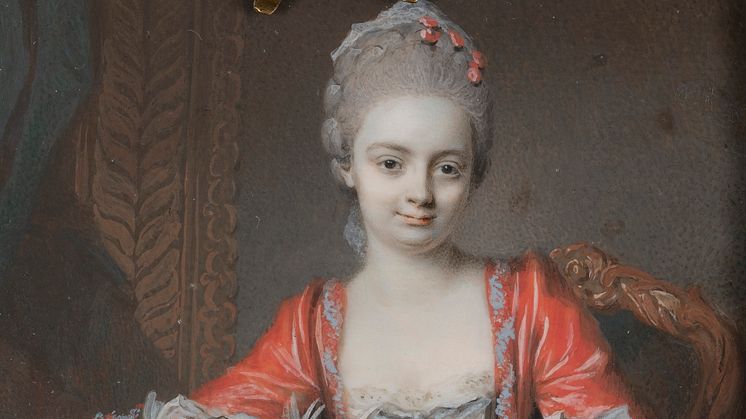
Press release -
Two portraits of women by miniaturist Alphen to the collections of Nationalmuseum
Nationalmuseum has acquired two portraits of women created by the Austrian court miniaturist Johann Eusebius Alphen in 1767. The portrayals of the models are unusually vivid, and the artist has even been carefully rendering the setting. The two portraits are unique because few signed works by Alphen have survived, as the artist was just 31 years old when he died.
In the mid-18th century, if a young artist wanted to further educate himself in miniature painting, Paris was one of the most interesting places to be. The city’s leading name was Jean-Baptiste Massé, a member of the academy and royal court painter. He revitalised miniature painting with his loose and unconventional brush technique. By this time Massé was no longer active as an artist, because he had started to have problems with his eyesight around 1740 and therefore declined to take on any more royal commissions.
Although Massé had essentially ceased painting, he would continue to play an important role as a teacher. In February 1764, the Austrian Johann Eusebius Alphen (1741–1772) came to Paris and was introduced to the French miniaturist. Yet Alphen was not the only student who quickly rose to favour. That same year, he faced competition from the Dane Cornelius Høyer, who also became a lodger with Massé until the master’s death in 1767. The two young artists, who were even the same age, each acquired the same technique of using loose brushwork. Alphen in particular became a virtuoso, as evidenced by the two recently acquired portraits of women. On their faces, he has combined a refined line and dot technique with a fluid brushstroke to depict clothing and other accessories. White highlights reinforce the sense of materiality and illusionism. This approach is reminiscent of pastel painting, in which Alphen was also skilled. As with his teacher Massé, the red and yellow dyes have faded into carnation, contributing to the unusually bright, powdered look of the faces. Only blue and grey halftones remain.
Both portraits are signed and dated “Peint par Alphen 1767”. It is unclear whether they were painted while the artist was still in Paris or recently after his arrival in Vienna. The younger lady, dressed in red, sits at a table with notes and a pen in front of her, as well as a book in one hand. The Canadian Mozart specialist Cliff Eisen of King’s College London has floated the theory that this young woman is Wolfgang Amadeus Mozart’s sister Maria Anna, nicknamed Nannerl, who was five years older than the composer. Alphen’s portrait has a direct counterpart in a Swiss private collection. This preliminary study purportedly has ownership-related links to other Mozart portraits. Even if this were not the case, Alphen met the Mozart family on several occasions. The first time was in Brussels in 1763, then three years later in Paris and finally in Vienna in 1767–68. Their last encounter was in Milan in 1771, where Alphen had a one-on-one rendezvous with Mozart, who mentions their meeting in a letter to his sister Nannerl.
So who is this young woman in red? It is undoubtedly the same model as in the sketch, but is she Maria Anna Mozart? The portrait acquired by Nationalmuseum bears the signature “Comtesse von Lebel”. No countess with this name is known to have lived, but could the name could be a euphemism for the Baroness Berchtold von Sonnenburg, the real Nannerl? In truth, this woman bears little resemblance to other famous representations of Mozart’s sister from around the same time. While this little mystery may never be answered, we can still appreciate the fact that Alphen’s two portraits are unusual examples of the artist’s great virtuosity as a miniaturist.
Nationalmuseum receives no public funding for the acquisition of artworks but relies on donations and gifts from private individuals and foundations to enrich its collections. The acquisition has been made possible by generous contributions from Hjalmar and Anna Wicander’s donation funds.
Inventory number:
Johann Eusebius Alphen, Portrait of Countess van Lebel, 1767. Watercolour and gouache on ivory. NMB 2785.
Johann Eusebius Alphen, Portrait of a Lady in Blue Dress, 1767. Watercolour and gouache on ivory. NMB 2786.
For further information, please contact
Magnus Olausson, Director of Collections, magnus.olausson@nationalmuseum.se +46 (0)8 5195 4371
Hanna Tottmar, Head of Press, press@nationalmuseum.se, +46 (0)8 5195 4400
Categories
Nationalmuseum is Sweden’s museum of art and design. The collections include paintings, sculpture, drawings and graphic art from the 16th century up to the beginning of the 20th century and the collection of applied art and design up to the present day. The museum building closed for renovation in 2013 and reopened in autumn 2018.

